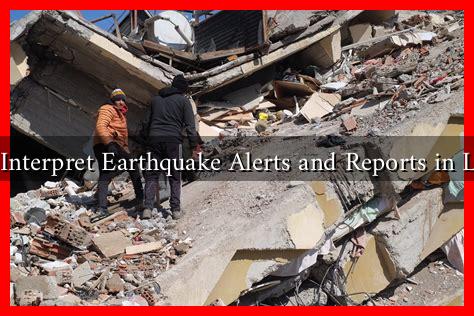-
Table of Contents
How to Interpret Earthquake Alerts and Reports in Lebanon
Lebanon is situated in a seismically active region, making it susceptible to earthquakes. Understanding how to interpret earthquake alerts and reports is crucial for the safety and preparedness of its residents. This article aims to provide a comprehensive guide on how to effectively interpret these alerts and reports, ensuring that individuals and communities can respond appropriately in the event of seismic activity.
The Importance of Earthquake Alerts
Earthquake alerts serve as early warning systems that can save lives and reduce property damage. In Lebanon, where the risk of earthquakes is significant, these alerts are vital for public safety. The Lebanese National Center for Geophysics (LNCG) plays a crucial role in monitoring seismic activity and disseminating information to the public.
Understanding Earthquake Alerts
Earthquake alerts are typically issued based on the magnitude, depth, and location of seismic events.
. Here are some key components to consider when interpreting these alerts:
- Magnitude: This indicates the energy released during an earthquake. Magnitudes are measured on the Richter scale or the moment magnitude scale (Mw). A magnitude of 4.0 or lower is generally considered minor, while anything above 7.0 is classified as major.
- Depth: The depth of an earthquake can significantly affect its impact. Shallow earthquakes (less than 70 km deep) tend to cause more damage than deeper ones.
- Location: The proximity of the earthquake’s epicenter to populated areas is crucial. An earthquake occurring near a major city can have devastating effects, even if its magnitude is moderate.
Reading Earthquake Reports
Earthquake reports provide detailed information about seismic events. Here’s how to read them effectively:
- Event Time: The time of the earthquake is usually reported in Coordinated Universal Time (UTC). Convert this to local time for accurate understanding.
- Epicenter Coordinates: Reports include latitude and longitude, which help in identifying the exact location of the earthquake.
- Intensity Reports: These indicate how strongly the earthquake was felt in different areas. The Modified Mercalli Intensity (MMI) scale is often used, ranging from I (not felt) to XII (total destruction).
Case Studies: Recent Earthquakes in Lebanon
To illustrate the importance of understanding earthquake alerts and reports, let’s examine a couple of recent seismic events in Lebanon:
- 2020 Beirut Explosion: Although not an earthquake, the explosion was felt like one. The LNCG issued alerts that helped residents understand the nature of the event, preventing panic.
- 2019 Tripoli Earthquake: A magnitude 5.0 earthquake struck near Tripoli. The LNCG provided timely alerts, allowing residents to take cover and emergency services to prepare for potential aftershocks.
Staying Informed: Resources and Tools
Staying informed about seismic activity is essential for preparedness. Here are some resources and tools available in Lebanon:
- Lebanese National Center for Geophysics (LNCG): The primary source for earthquake alerts and reports.
- Mobile Apps: Several apps provide real-time alerts and information about seismic activity, such as “Earthquake Alert!” and “MyShake.”
- Social Media: Follow LNCG on platforms like Twitter and Facebook for immediate updates.
Conclusion
Interpreting earthquake alerts and reports in Lebanon is essential for ensuring public safety and preparedness. By understanding the key components of alerts, reading reports accurately, and utilizing available resources, residents can better respond to seismic events. As Lebanon continues to face the threat of earthquakes, staying informed and prepared is not just advisable; it is imperative for the safety of all citizens.





